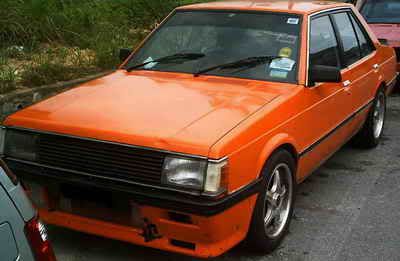
My site is worth $321.2.
How much is yours worth?
I suspected my SR20DE from my SR70(a combination of KE70 and SR20) is running very rich coz everytime I pour RM20 of fuel, estimated about 10 litres of RON 92 petrol, it will only last for less than 50km normal city drive.
Firstly, I noticed that my exhaust outlet can has a thick of carbon, see pic below.

Secondly, when doing an inspection on a spark plug, it was clear that it was fully covered by a carbon, see pics below.


Now it is very clear that with this 3 factors
1. poor fuel economy,
2.dirty exhaust
3.and a thick carbon on spark plugs
definately concludes that air fuel ratio is in 'rich' region, in other words, too much fuel supply on combustion chamber which is known to restrict it full performance. It will not give you maximum output of your engine power, but car is much slower on its accelaration and will lead to a some bad things for the engine components such as plugs, valve , combustion chamber surface and exhaust outlet.
NOTE: Rich mixture is describe as too much petrol.
Lean mixture is describe as less petrol.
But a question arise here, do you think rich condition happen all the way from idling until redline of the rpm?or just on high rpm(5000 and above) or may be medium rpm(3000-5000) or low rpm(2000-3000)?
To answer this question, we need an A/F ratio analyzer to display for our eyes too see which range of rpm is affected.FYI any brand will do but I will be getting a Peak Air-Fuel Ratio Analyzer from PS Powersport. It will show us a everything about rich and lean mixture and from there we can decide where to start on the troubleshooting. Well, this item also very helpful for engine tuning., as my friend has been using it together with PS Fuel Enhancer II to tune his modded 1jz-gte and it helped him to advance to the final stage of Tawau Drag last 2 years with only using stock ECU, he then secured 2nd place of 2-wheel Turbo category in the competition.

Finally a PS Peak Air-Fuel Ratio analzyer is installed. I managed to fix it into the instrument cluster to avoid from stolen. Now I am ready to give my data on how my ecu perform, it's as simple as RICH and LEAN.
What do you know about rich and lean?
It is about Air/Fuel Ratio tuning: Rich v. Lean, why lean makes more power but is more dangerous? When discussing engine tuning the 'Air/Fuel Ratio' (AFR) is one of the main topics. Proper AFR calibration is critical to performance and durability of the engine and it's components. The AFR defines the ratio of the amount of air consumed by the engine compared to the amount of fuel.
A 'Stoichiometric' AFR has the correct amount of air and fuel to produce a chemically complete combustion event. For gasoline engines, the stoichiometric , A/F ratio is 14.7:1, which means 14.7 parts of air to one part of fuel. The stoichiometric AFR depends on fuel type-- for alcohol it is 6.4:1 and 14.5:1 for diesel.
So what is meant by a rich or lean AFR? A lower AFR number contains less air than the 14.7:1 stoichiometric AFR, therefore it is a richer mixture. Conversely, a higher AFR number contains more air and therefore it is a leaner mixture.
For Example:
15.0:1 = Lean
14.7:1 = Stoichiometric
13.0:1 = Rich
Leaner AFR results in higher temperatures as the mixture is combusted. Generally, normally-aspirated spark-ignition (SI) gasoline engines produce maximum power just slightly rich of stoichiometric. However, in practice it is kept between 12:1 and 13:1 in order to keep exhaust gas temperatures in check and to account for variances in fuel quality. This is a realistic full-load AFR on a normally-aspirated engine but can be dangerously lean with a highly-boosted engine.
Let's take a closer look. As the air-fuel mixture is ignited by the spark plug, a flame front propagates from the spark plug. The now-burning mixture raises the cylinder pressure and temperature, peaking at some point in the combustion process.
The turbocharger increases the density of the air resulting in a denser mixture. The denser mixture raises the peak cylinder pressure, therefore increasing the probability of knock. As the AFR is leaned out, the temperature of the burning gases increases, which also increases the probability of knock. This is why it is imperative to run richer AFR on a boosted engine at full load. Doing so will reduce the likelihood of knock, and will also keep temperatures under control.
There are actually three ways to reduce the probability of knock at full load on a turbocharged engine:
reduce boost,
adjust the AFR to richer mixture, use PS Fuel Enhancer II
and retard ignition timing. use PS ignition timing kit.
These three parameters need to be optimized together to yield the highest reliable power.
to be continued

My site is worth $321.2.
How much is yours worth?

No comments:
Post a Comment